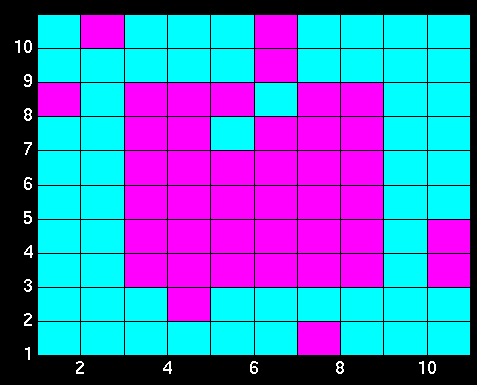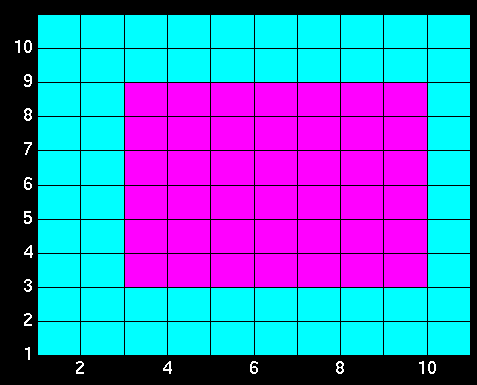Hopfield networks and Boltzmann machines
�
Section on
Boltzmann machines will not be covered in 1999.
Readings
Required readings: Chapter 12 and sections 10.1 and 10.8 in coursepack article
"Neural network approaches to solving hard problems".
In 1999, we will only cover the sections in chapter 12 up to page 413.
Definition of a Binary Hopfield Network
The standard binary Hopfield network is a recurrently connected network with
the following features:
- symmetrical connections: if there is a connection going
from unit j to unit i having a connection weight equal to
W_ij then there is also a connection going from unit i to
unit j with an equal weight.
- linear threshold activation: if the total weighted summed
input (dot product of input and weights) to a unit
is greater than or equal to zero, its state is set to 1, otherwise it is
-1. Normally, the threshold is zero. Note that the Hopfield network for the
travelling salesman problem (assignment 3) behaved slightly differently from
this.
- asynchronous state updates: units are visited in random
order and updated according to the above linear threshold rule.
- Energy function: it can be shown that the above state
dynamics minimizes an energy function.
- Hebbian learning
The most important features of the Hopfield network are:
- Energy minimization during state updates guarantees that it will
converge to a stable attractor.
- The learning (weight updates) also minimizes energy; therefore,
the training patterns will become stable attractors (provided the capacity has
not been exceeded).
However, there are some serious drawbacks to Hopfield networks:
- Capacity is only about .15 N, where N is the number of
units.
- Local energy minima may occur, and the network may
therefore get stuck in very poor (high Energy) states which do not satisfy the
"constraints" imposed by the weights very well at all. These local minima are
referred to as spurious attractors if they are stable
attractors which are not part of the training set. Often, they are blends of
two or more training patterns.
The Boltzmann machine, described below, was designed to overcome these
limitations.
Hopfield network demo
The following matlab program sets up a Hopfield network having units arranged
in a 2-dimensional grid with local connectivity. Each unit is symmetrically
connected to its four nearest neighbors on the grid and the connection weights
are all equal to 1.0.
This example is described further in
Anderson, Chapter 12. To achieve a minimum in energy, every unit should agree
with its four neighbors. Thus, all units should be in the same state to
achieve a mininum energy configuration.
The states of the units in the network are initialized
as follows: a central square of units are
turned on, the rest are turned off, and then all units are
randomly flipped with probability 0.1.
 Here is an example of the initial state of the
network.
Here is an example of the initial state of the
network.
For this network, there are only two global energy minima, one with all
units on and one
with all units off. After settling, however, the network usually ends up in a
"blend state" which is a blend of the two global minima.
 Here is an example of the final state of the
network after settling. This is a local minimum, sometimes called a
spurious attractor.
Here is an example of the final state of the
network after settling. This is a local minimum, sometimes called a
spurious attractor.
Matlab code:
You can run the above demo by loading initHopfield, and then repeatedly
loading forwardHopfield. Each time forwardHopfield is run, you should then call
plotHopActivations, to display the states of all units in the network in a
2-dimensional layout.
Boltzmann Machines
The binary Boltzmann machine is very similar to the binary Hopfield network,
with the addition of three features:
- Stochastic activation function: the state a unit is in is
probabilistically related to its Energy gap. The bigger the energy
gap between its current state and the opposite state, the more likely the unit
will flip states.
- Temperature and simulated annealing: the probability that
a unit is on is computed according to a sigmoid function of its total weighted
summed input divided by T. If T is large, the network behaves very randomly. T
is gradually reduced and at each value of T, all the units' states are
updated. Eventually, at the lowest T, units are behaving less randomly and
more like binary threshold units.
- Contrastive Hebbian Learning: A Boltzmann machine is
trained in two phases, "clamped" and "unclamped". It can be trained either in
supervised or unsupervised mode. Only the supervised mode was discussed in
class; this type of training proceeds as follows, for each training pattern:
- Clamped Phase: The input units' states are clamped to (set and
not permitted to change from) the training pattern, and the output units'
states are clamped to the target vector. All other units' states are
initialized randomly, and are then permitted to update until they reach
"equilibrium" (simulated annealing). Then Hebbian learning is applied.
- Unclamped Phase: The input units' states are clamped to
the training pattern. All other units' states (both hidden and output) are
initialized randomly, and are then permitted to update until they reach
"equilibrium". Then anti-Hebbian learning (Hebbian learning with a
negative sign) is applied.
The above two-phase learning rule must be applied for each training pattern,
and for a great many iterations through the whole training set. Eventually,
the output units' states should become identical in the clamped and unclamped
phases, and so the two learning rules exactly cancel one another. Thus, at
the point when the network is always producing the correct responses, the
learning procedure naturally converges and all weight updates approach zero.
The stochasticity enables the Boltzmann machine to overcome the problem of
getting stuck in local energy minima, while the contrastive Hebb rule allows
the network to be trained with hidden features and thus overcomes the capacity
limitations of the Hopfield network. However, in practice, learning in the
Boltzmann machine is hopelessly slow.
In class, we saw a demonstration on overhead transparencies of the
Boltzmann machine performing figure-ground segregation. This
network was hard-wired (i.e. hand-selected weights, no learning). Some units
were designated as "edge units" which had a particular direction and
orientation,
while others were designated as "figure-ground units". At each image location
there was a full set of edge units in every possible orientation (horizontal
or vertical) and direction (left, right, up or down), and a full set of
figure/ground units (one of each). The weights could be
excitatory or inhibitory, and represented particular constraints amongst the
figure/ground and edge units. For example, an edge unit at one location would
inhibit the edge unit of the same orientation but opposite direction at the
same location. Another example: a vertical right-ward pointing edge
unit would excite a figure unit at the next image local to the right, and
inhibit a ground unit at that location, and would inhibit the figure unit to
the left and excite the ground unit to the left. The entire network was
initialized with the appropriate edge units turned on, and all other units
off, and then all units were randomly flipped with some small probability so
that the input was noisy. Units states were then updated using simulated
annealing. The network was shown to be able to fill in
continuous regions and label them as either figure or ground. The region could
be non-convex (e.g. the letter C). The network could also fill in
non-continuous edges, exhibiting "illusory contours".
![[Previous]](prevsec.gif)
![[Parent]](parntsec.gif)
![[Next]](nextsec.gif)
 Here is an example of the initial state of the
network.
Here is an example of the initial state of the
network.
 Here is an example of the initial state of the
network.
Here is an example of the initial state of the
network.
 Here is an example of the final state of the
network after settling. This is a local minimum, sometimes called a
spurious attractor.
Here is an example of the final state of the
network after settling. This is a local minimum, sometimes called a
spurious attractor.